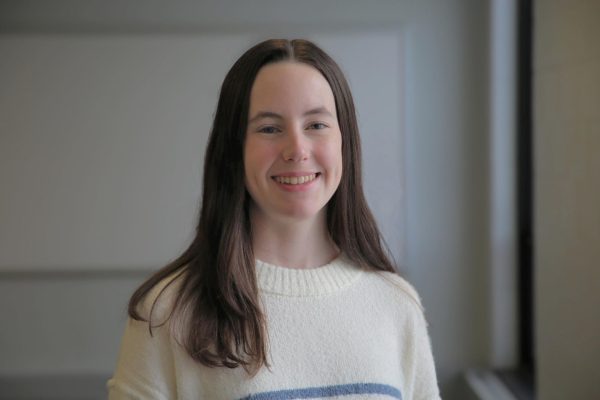Borders are everywhere, in the natural dividing lines of the environment, in the manmade maps separating farms from cities, in the way people communicate with one another. Borders can bring people and places together or split them apart.
This is the theme of “Walking the Edge,” a multimedia art exhibit hosted by The Schuylkill Center for Environmental Education.
The Schuylkill Center is a not-for-profit urban environmental education center. Founded in 1965, they provide environmental education through their “four interrelated departments: environmental education, environmental art, land stewardship, and wildlife rehabilitation,” according to The Schuylkill Center website. The center encourages people to examine their relationship to nature through its variety of programs, exhibits, hiking trails and more.
“Walking the Edge” is the most recent program. With submissions from over 100 artists, the exhibit contains art of different mediums using the theme of borders and boundaries to form a sense of community and reflection.
A projector displays a slideshow of images on one wall, and in the center of the room is a collection of walking sticks covered in illustrations painted by Jolie Chylack, who explains on the sticks’ plaque that they were found in Lenapehoking [Land of the Lenape]. The other three walls are lined with photos, paintings, sculptures, poems and even a quilt.
“I love the way the framework for a community exhibit like this brings together such a wide and varied body of work,” said JJ Tiziou, curator of “Walking the Edge.” “It’s just been really rewarding to put it together.”
Tiziou is also the organizer of “Walk Around Philadelphia,” a program that invites people to walk the border of Philadelphia every February and September. The 100-mile walk is broken up differently every time, but this February it will take place over the course of three weekends, Tiziou said.
On Feb. 25, “Walk Around Philadelphia” participants will depart from The Schuylkill Center and walk roughly nine miles along the city’s edge to Hawk Hill, which rests on the border of West Philly.
“Walk Around Philadelphia” is where the theme of “borders and boundaries” originates as they are an integral part of the experience of walking the city’s edge. For Tiziou, the event brings up questions of accessibility and inclusivity, and he is constantly working to expand who can participate in the walks while also celebrating how it has brought people together.
“I think a lot about some of the borders that separate us,” Tiziou said. “So when we think about class privilege or politics, where do we tend to stay in our group? And what is it like to make those borders porous a little bit?”

Tiziou has been passing by The Schuylkill Center, which sits on the edge of Northwest Philly, since he first walked the city’s border in 2016 and had been visiting the center for years before that. When The Schuylkill Center asked Tiziou about curating an exhibit based on “Walk Around Philadelphia,” it was a natural partnership, Tiziou said.
Although Tiziou and The Schuylkill Center extended the open call for art beyond participants of “Walk Around Philadelphia,” many of the submissions are photos from people who have taken part in the walks.
This includes St. Joe’s own Mark Brown, administrative coordinator in the department of physical therapy, who submitted two photos to the exhibit and completed two segments of the walk in September 2022.
Brown’s photos are two different perspectives of the same location: an abandoned pier along the Delaware River, south of Pier 68, with a worn-down building that looks like it could’ve at one point been a factory.
The first photo is of the chain-link fence that serves as the boundary between the main sidewalk and the pier with the factory out of focus through the gaps. Hanging on the fence is a sign labeled “Danger! No access!” that has been covered in graffiti and sports a “Walk Around Philadelphia” sticker.
The second photo is taken on the other side of the fence, the old building in full view with a beautiful sky behind it.
“Often, we can be confronted with barriers or what might seem like insurmountable challenges like, ‘How am I going to get past this fence?’” Brown said. “And then to discover that there was a hole cut in the fence by someone else … it spoke to me of hope, and that you can find beauty even in an abandoned, industrial, graffiti-ridden space.”
Brown said projects like “Walking the Edge” are important for showing all the different perspectives that can stem from exploring the borders and boundaries of a place like Philadelphia.
“I’m always interested in seeing other people’s experience,” Brown said. “What I find is that either, I’m learning something new, seeing something from a completely different perspective or I’m encountering an expression or an articulation of something that resonates with me.”
Indeed, the sheer talent and number of unique viewpoints represented in “Walking the Edge” are a testament to how walking and exploring borders can bring people closer to each other and to nature.
“Our understanding of our world is expanded by exploring [the city’s edge],” Tiziou said. “There are things we pushed to the margins like toxic waste sites, like shipyards, like prisons. … When you go walking by them, you get a richer understanding of how all these bits of ecosystems and infrastructure and all of our worlds weave together.”

















































